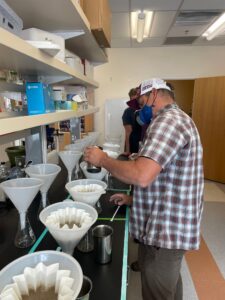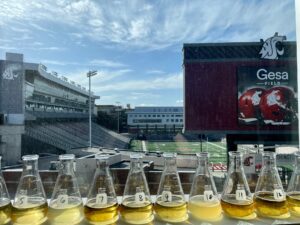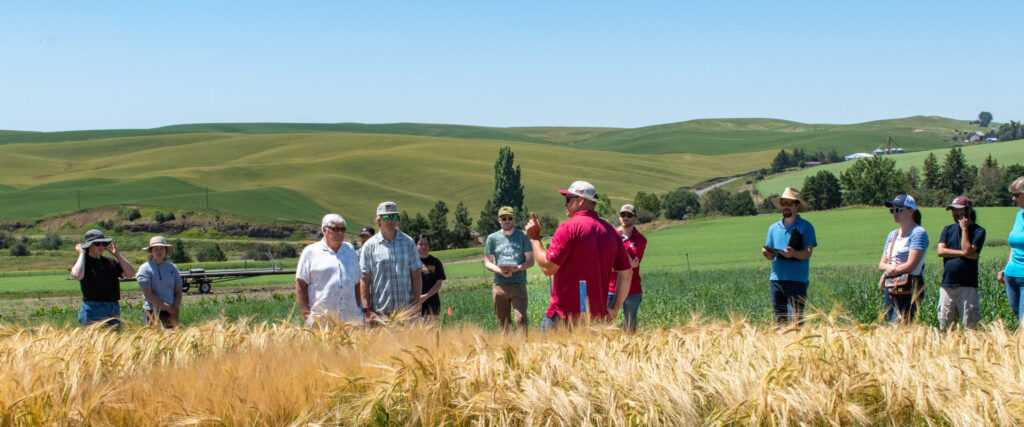By Robert Brueggeman
The production of malt barley across the U.S. supports a multibillion dollar industry that includes the added value created by the brewing and distilling industries.

My goal, as the Robert A. Nilan Endowed Chair in Barley Research and Education and Washington State University’s (WSU) barley breeder, is to develop modern malt barley varieties adapted to the dryland growing regions of the state that consistently contain the malting package demanded by commercial adjunct brewers as well as the more creative liquid arts of the craft brewers and distillers. I think the excellent craft brewers and distillers in the state will play a major role in getting products made with Washington-sourced barley to consumers, which will help bring recognition to Washington as a premium malt barley production region.
In the pursuit of developing these high quality, high yielding malt barley varieties, there was an initial focus on enhancing the program’s germplasm such that it was enriched for the genetics to increase our probability of identifying barley lines that, when malted, resulted in more than 80% malt extract. This equates to an enzyme package that results in more than 80% of the dry weight of the mature grain becoming beer or distilled spirits, which is the main criteria of a quality malt barley variety. This goal meant that the germplasm in the program needed to be enhanced for malt barley genetics, which was achieved through hundreds of crosses with elite malt barley lines collected from programs around the world.

Research has shown that climate change and the resulting extremes in weather patterns worldwide presents major challenges to ensuring adequate production of quality malting barley to meet the needs of the brewing and distilling industries, domestically and globally. These extremes result in substantial yield losses, typically ranging from 3-17% depending on the severity of conditions, yet can be much more severe when conditions are extreme, such as the drought and heat experienced in the Pacific Northwest (PNW) during the 2021 growing season. These drought and extreme temperatures also have a major effect on malt quality that leads to rejection of the crop by the malting houses. Thus, ensuring a stable supply of quality malting barley requires the development of varieties with wide adaptability and a stable malt quality genetic package.
Although the PNW has experienced some climate extremes resulting in production shortfalls and quality issues during some growing seasons, our situation is not as dire as some barley production regions. The PNW is predicted to have increased winter and spring precipitation and hotter, dryer summers, which could be advantageous to producing quality malt barley when adapted varieties are grown. One advantage Eastern Washington has had in the production of high quality barley is the lack of major diseases that affect quality and yield, such as those seen in the traditional malt barley production region of the upper Midwestern states. Part of this equation is that dryer weather patterns during the midsummer months are not conducive to the development of fungal diseases, which is a major issue when it comes to producing quality malting barley. Varieties adapted to utilize moisture early in the growing season and that mature early to avoid the heat during grain fill can be developed through reeding of both spring and winter malt barley varieties. Climate extremes and disease issues causing global and domestic shortfalls may also increase demand for barley produced in the PNW, creating new opportunities for domestic and international export markets.
Developing quality malt barley varieties that have broad adaptability is not an easy task. Bringing together the optimal genetic package to meet all the quality parameters and maintain the genetics for broad adaptation and excellent agronomics can be a tall order. However, through funding from the Washington Grain Commission, the American Malting Barley Association, the U.S. Department of Agriculture’s (USDA) Agricultural Research Service barley pest initiative, and federal grant funding from the USDA National Institute of Food and Agriculture and National Science Foundation, my program is making excellent progress in meeting these goals.
A major tool to meeting these breeding goals was the addition of the WSU Malt Quality Lab (WMQL), which was made possible by equipment funding through the Washington Grain Commission. Adding this important instrumentation and program infrastructure allows us to quickly generate the full spectrum of malt quality data on our experimental lines in real time as the grain comes off the field. This capability is instrumental in our selection process and our ability to know which lines to move forward and which lines become new parental materials in our breeding cycle. This resource has had measurable implications for the WSU spring and winter malt barley breeding program as we are now able to generate malt quality data at the early generation and move lines that have adequate malt quality forward into replicated field trials.
This early generation selection, which was not previously possible, optimizes our breeding efforts by not expending resources on lines that are not adequate. The WMQL became fully operational in September 2021, and we generated malt quality data from our 2021 single rep yield trials and were able to select material with adequate malt quality to move forward in our 2022 replicated yield trials, enriching these trials for quality. With our previous process of generating malt quality data utilizing the USDA Cereal Crops Research Lab in Madison, Wis., we did not receive data back in time to make selections for the next planting season. The WMQL saves us a year in making selections as we can separate “the goats from the sheep” during early generation selection, significantly enhancing our ability to identify the individual lines that will be “winners” as malt barley varieties.
The major goal of the WSU spring and winter malt barley breeding program is the development of varieties that make the American Malting Barley Association (AMBA) recommended list. It is necessary to have varieties accepted and added to the AMBA recommended list to have varieties contracted with the large malting facilities like Great Western Malting. Although we will continue to develop all malt varieties directed at the craft malting, brewing and distilling industries as this sector is demanding increased malt barley acreage, it is the adjunct malt barley lines that will demand the large commercial acreage that we are targeting in the future. Thus, my program is focusing on crosses and advancement of material enhanced for quality to make AMBA specifications for adjunct and craft all-malt parameters.
To aid the rapid early generation selection process in our breeding cycle, we also equipped the WSU barley breeding and molecular lab with the capability to run DNA markers. The WMQL has greatly enhanced our selection processes utilizing molecular markers as we are now able to generate high quality malt data on experimental lines and genetic populations to map positive genetic loci contributing to malt quality. From these data, we developed DNA markers associated with malt quality traits that initially focused on malt extract, low protein and low beta-glucan, which were the three main malt quality characteristics that were lacking in the program to make AMBA recommendation.
The optimization of our genetics and selection processes using high throughput genotyping and phenotyping has had measurable impact on the return on the Washington Grain Commission’s funding investment in the WSU barley breeding program. In the two prior years of malt quality analysis of experimental lines coming down the pipeline, we did not identify a single line that met the strict parameters required of a line to enter the AMBA pilot evaluation program. However, in 2021, our malt quality analysis of new experimental lines identified several lines that met or exceeded these quality parameters as compared to the AMBA western state malt quality controls, Copeland and AC Metcalfe. Excitingly, four of these lines yielded significantly higher than the modern AMBA recommended varieties Odyssey and Opera. Thus, the research investments have expedited the development of lines that we will submit for the AMBA pilot evaluation program in 2022.
Thus, our focus on stabilizing malt quality genetics in our breeding material while selecting for yield is producing exciting results. It is my goal to report on the development and release of the first WSU AMBA recommended malting variety soon, which would be the first hurdle in bringing the WSU malt barley breeding program recognition as a world-class malt barley breeding program. I believe Washington state has the potential to become a major producer of malting barley for both domestic use and for the world market.

This article originally appeared in the October 2022 issue of Wheat Life Magazine.

Robert Brueggeman, Ph.D.
Robert Brueggeman, Ph.D., holds the Robert A. Nilan Endowed Chair in Barley Research and Education at Washington State University. His breeding program focuses on the development of high-quality spring and winter malting barley varieties that are widely adapted to diverse regions of Washington State. Read more about Dr. Brueggeman..
